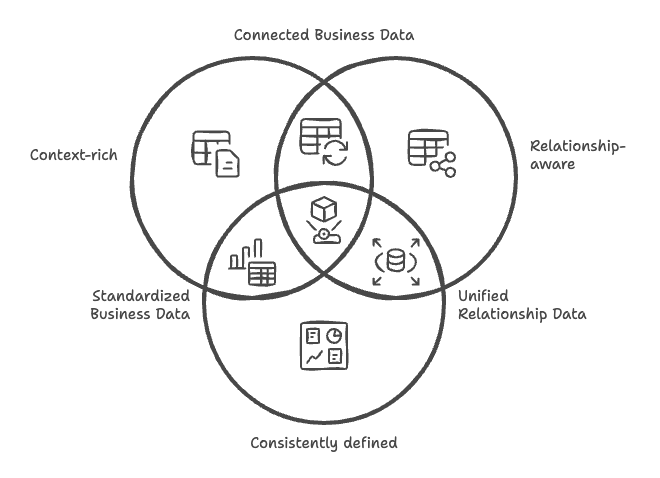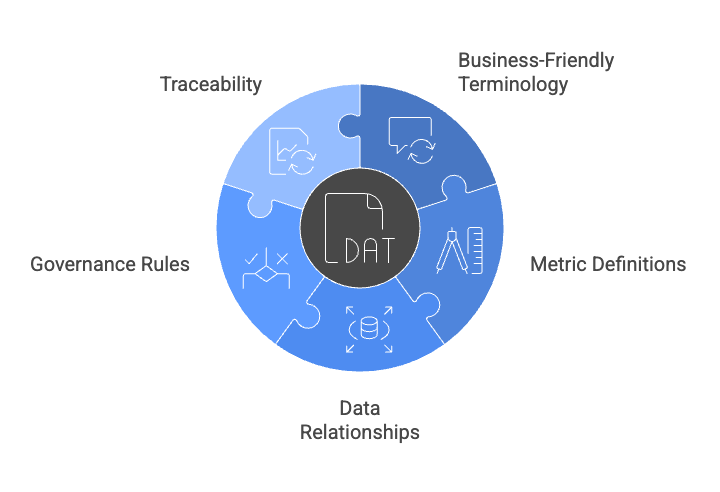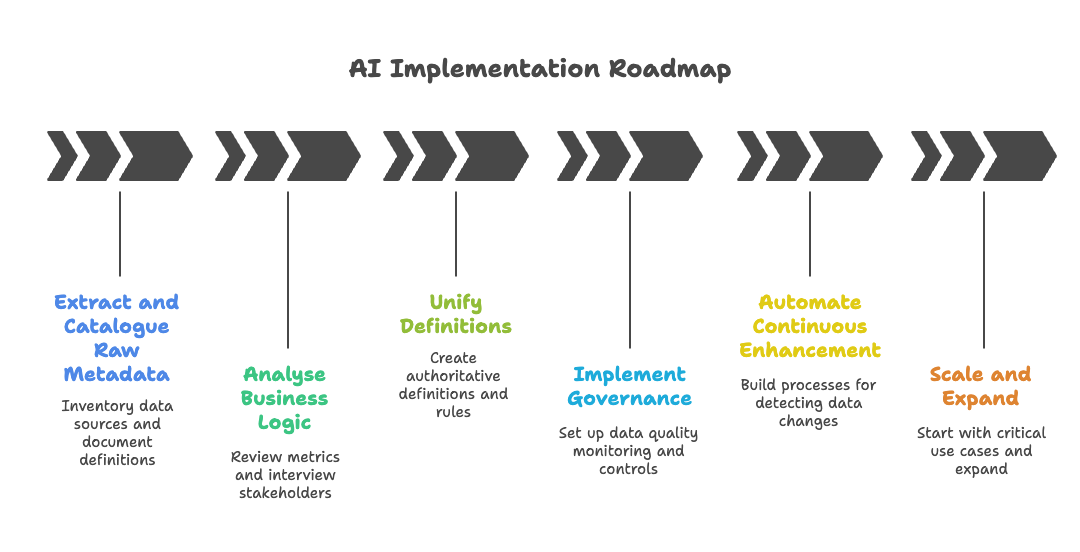#030 - Your AI models are hallucinating because of bad data architecture
Why semantic layers are the missing foundation for trustworthy AI
Here's an uncomfortable truth: Your AI initiatives aren't failing because of algorithm problems.
They're failing because your data architecture is fundamentally broken for AI consumption.
Most organisations are feeding AI systems the data equivalent of a foreign language dictionary with half the pages missing. No context. No relationships. No business meaning.
Then they wonder why their models make bizarre predictions and their AI assistants give inconsistent answers.
I've been analysing why some companies get extraordinary results from AI while others burn through millions with nothing to show for it. The difference isn't computing power or model selection.
It's whether they've built semantic layers into their data architecture.
Today, let's fix your AI data foundation.
What Actually Makes Data "AI-Ready"
Most data teams think AI-ready means "lots of clean data in the cloud."
Wrong.
AI-ready data has three non-negotiable characteristics:
Context-rich: The data carries business meaning, not just values
Relationship-aware: Connections between entities are explicit and maintained
Consistently defined: Metrics mean the same thing across all systems and models
Here's the reality check: Unstructured data is growing at a rate of 55-65% annually. Your AI models are drowning in information but starving for understanding.
Without semantic layers, you're asking AI to be a fortune teller with incomplete information.
The Semantic Layer Solution (Beyond the Buzzwords)
A semantic layer is your data's business translator.
Simple definition: It's a logical interface that converts raw technical data into meaningful business concepts that both humans and AI can understand reliably.
Think of it this way: Instead of feeding your AI model database fields like "cust_acq_dt_ts" and "rev_rec_amt_adj," your semantic layer provides clear concepts, such as "Customer Acquisition Date" and "Recognised Revenue."
The core building blocks:
Business-friendly terminology that eliminates technical jargon
Metric definitions that stay consistent across all applications
Data relationships that preserve business logic
Governance rules that ensure quality and compliance
Traceability that tracks data lineage for trust and debugging
Why this matters for AI: Large language models and machine learning algorithms perform dramatically better when they understand what data represents, not just what it contains.
Why AI Demands Semantic Context (The Trust Problem)
Here's what happens when AI systems lack semantic understanding:
Scenario 1: The Revenue Confusion. Your AI model is trained to predict customer churn using "revenue" as a key factor. But your data warehouse has:
Gross revenue (from sales system)
Net revenue (from finance system)
Recognised revenue (from accounting system)
Without semantic layers, your model randomly selects whichever revenue field is easiest to access, leading to wildly inconsistent predictions.
With semantic layers: Your model always uses "Recognised Revenue" with clear business rules about when and how it's calculated.
Scenario 2: The Customer Identity Crisis. Your recommendation engine needs to understand "active customers."
Your systems define this as:
Users who logged in this month (product team)
Accounts with recent purchases (sales team)
Paying subscribers (finance team)
Without semantic layers, your recommendations are based on whichever definition happens to be in the training data.
With semantic layers, the term "Active Customer" has a single, authoritative definition that all AI systems use consistently.
The business impact: Companies with semantic layers report 40% fewer AI model failures and 60% higher accuracy in business predictions.
The Core Challenges Killing Your AI Projects
Challenge 1: Volume Without Meaning
The problem: You're collecting massive amounts of data but losing business context in the process
The cost: Data scientists spend 80% of their time figuring out what data means instead of building models
The fix: Semantic layers embed meaning directly into your data architecture
Challenge 2: Data Silos and Fragmentation
The problem: Critical business data is scattered across 15+ systems with no unified language
The cost: AI models can't connect related information, leading to incomplete insights
The fix: Semantic layers create a universal business vocabulary across all systems
Challenge 3: Quality and Integration Nightmares
The problem: Poor data quality cascades through AI systems, multiplying errors
The cost: One bad data definition can invalidate months of AI development work
The fix: Semantic layers enforce quality rules and consistent definitions at the source
Challenge 4: Trust and Explainability
The problem: Business stakeholders can't trust AI outputs they don't understand
The cost: AI projects get abandoned because leaders can't verify the logic
The fix: Semantic layers make AI decisions traceable back to business concepts
How Semantic Layers Transform AI Outcomes
For Machine Learning Models:
Before: Models trained on inconsistent, poorly labelled data with cryptic field names
After: Models trained on business-meaningful data with clear relationships and definitions
Result: 40% improvement in model accuracy and 60% reduction in training time
For AI-Powered Analytics:
Before: AI assistants give different answers depending on which data source they access
After: AI systems provide consistent insights because they're working from unified business definitions
Result: 70% increase in business user trust and adoption
For Natural Language Interfaces:
Before: "Show me revenue trends" produces different results depending on how the query is interpreted
After: AI understands exactly what "revenue" means in your business context
Result: Self-service analytics adoption increases 3x because results are predictable
Real example: A financial services firm implemented semantic layers, and their fraud detection AI improved from 60% accuracy to 85% accuracy. The difference? The model finally understood the business context of transaction patterns.
Your 6-Step Implementation Roadmap
Step 1: Extract and Catalogue Raw Metadata
Inventory all data sources feeding your AI systems
Document current field definitions and business logic
Identify inconsistencies and gaps in understanding
Step 2: Analyse Business Logic in Existing Systems
Review how metrics are calculated in current reports and dashboards
Interview business stakeholders about what data means to them
Map the gap between technical definitions and business understanding
Step 3: Unify Definitions Into a Standardised Model
Create authoritative definitions for core business concepts
Establish calculation rules that work across all systems
Build consensus among stakeholders (this is harder than the technology)
Step 4: Implement Governance and Access Controls
Set up data quality monitoring and validation rules
Establish ownership and approval processes for definition changes
Create audit trails for compliance and troubleshooting
Step 5: Automate Continuous Enhancement
Build processes to detect when underlying data structures change
Set up alerts when semantic definitions need updates
Create feedback loops from AI systems back to business definitions.
Step 6: Scale and Expand
Start with your most critical AI use cases
Gradually expand to additional data sources and applications
Measure impact on AI accuracy and business outcomes.
Timeline reality check: Plan 3-6 months for initial implementation, 6-18 months for full organisational adoption.
Real-World Impact (What Actually Changes)
For Data Teams:
Spend 70% less time explaining what data means
Reduce data preparation time for AI projects by 50%
Eliminate most "data definition" meetings and debates
For AI/ML Teams:
Model development cycles are 60% faster due to consistent, well-labelled data
Fewer model failures caused by data quality issues
Easier model explainability for business stakeholders
For Business Stakeholders:
Trust AI outputs because they understand the underlying logic
Self-service analytics actually works because definitions are clear
Faster time-to-insight for strategic decisions
Bottom line numbers:
Average 40% reduction in AI project timelines
60% improvement in model accuracy across use cases
3x increase in business user adoption of AI-powered tools
Strategic Implementation Advice
Start with your most significant AI pain point:
Which AI initiative is struggling with data consistency?
What business metric is defined differently across teams?
Where are you losing trust in AI outputs?
Don't boil the ocean:
Pick 3-5 core business concepts to start with
Focus on your most critical AI use cases first
Prove value before expanding to the entire organisation
Invest in the right tools:
Modern semantic layer platforms: Looker, ThoughtSpot, Cube.js
Cloud-native options: Databricks Semantic Layer, Snowflake's modelling
Budget range: $100K-$500K for enterprise implementation
Foster cross-team collaboration:
Get executive sponsorship for definition decisions
Include business stakeholders in technical design
Create shared ownership between data and business teams
Measure what matters:
AI model accuracy improvements
Time reduction in data preparation
Business user adoption rates
Trust and satisfaction scores.
The Competitive Reality
Here's what's happening in the market:
Companies with semantic layers are shipping AI products while competitors are still debugging data pipelines.
The window is closing fast. Early adopters are building sustainable competitive advantages through better AI outcomes. Late adopters will spend the next two years addressing data architecture issues instead of developing innovative AI solutions.
The choice is simple:
Option A: Keep feeding AI systems disconnected, poorly labelled data and wonder why nothing works
Option B: Build semantic layers now and watch your AI initiatives finally deliver business value
Semantic layers aren't a technical luxury; they're the business-critical foundation that separates successful AI companies from expensive AI experiments.
Your AI models are only as innovative as the data architecture you give them. Ensure that architecture speaks the business language, not just the database dialect.
If you're tired of watching AI projects fail because of data architecture problems, and you're ready to build the semantic foundation that makes AI work, it's time to implement semantic layers.
From my experience with complex data migrations at major enterprises, the pattern is clear: organisations that invest in proper data architecture see dramatically better AI outcomes than those that try to shortcut with flat tables and hope for the best.
Reply with 'AI-READY' if you want to discuss how semantic layers could fit into your specific data modernisation strategy.
Next week: "Platform deep-dive: Comparing Databricks, Snowflake, and standalone semantic layer solutions for AI workloads, including total cost of ownership analysis."
That’s it for this week. If you found this helpful, leave a comment to let me know ✊
About the Author
Khurram, founder of BigDataDig and a former Teradata Global Data Consultant, brings over 15 years of deep expertise in data integration and robust data processing. Leveraging this extensive background, he now specialises in organisational financial services, telecommunications, retail, and government sectors, implementing cutting-edge, AI-ready data solutions. His methodology prioritises value-driven implementations that effectively manage risk while ensuring that data is prepared, optimised, and advanced analytics.





